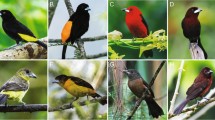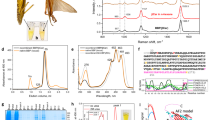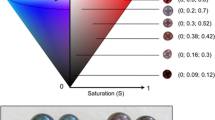Abstract
A SINGLE carotenoid pigment, astaxanthin, bound to specific proteins in a complex quaternary structure, provides shell coloration in the lobster Homarus americanus1–8. The absorption of light by these carotenoproteins is uniform over a remarkable spectral range, as evidenced by the reflectance of a blue shell fragment which is low (5–6%) and essentially constant from 400 to 700 nm (ref. 9). This uniform absorption cannot be assigned to any combination of the carotenoprotein complexes which have been isolated. To assess the significance of these chemical species and to make specific inferences about carotenoprotein function in vivo, it is essential to measure the absorption spectrum in situ10. Several astaxanthin–protein complexes which absorb in the visible region have been isolated and spectroscopically characterised1–9,11. These include α-and γ-crustacyanin with absorption maxima at 632 and 625 nm, respectively, and a second complex called the yellow protein7,11 which absorbs maximally at 410 nm. An early in situ absorption measurement of a carapace sample taken immediately after ecdysis and before calcification has been reported by Cheesman et al.4. However, the absence of structure in the reflectance measurements9 from a mature, opaque carapace suggests that conventional spectroscopy can yield little information about absorption maxima in situ. By using a new spectroscopic technique, photoacoustic spectroscopy (PAS), we have obtained spectra of a native shell fragment and here report the existence of a near continuum of astaxanthin absorption energies which span the visible spectral region. Furthermore, these pigments are in an anisotropic distribution within the endocuticle, that is, those absorbing in the blue are near the surface whereas those absorbing in the red are in the interior.
This is a preview of subscription content, access via your institution
Access options
Subscribe to this journal
Receive 51 print issues and online access
$199.00 per year
only $3.90 per issue
Buy this article
- Purchase on Springer Link
- Instant access to full article PDF
Prices may be subject to local taxes which are calculated during checkout
Similar content being viewed by others
References
Wald, G., Nathanson, N., Jencks, W. P. & Tarr, E. Biol. Bull. 95, 249–250 (1948).
Jencks, W. P. & Buten, B. Archs. Biochem. Biophys. 107, 511–520 (1964).
Cheesman, D. F., Lee, W. L. & Zagalsky, P. F. Biol. Rev. 42, 131–160 (1967).
Cheesman, D. F., Zagalsky, P. F. & Ceccaldi, H. J. Proc. R. Soc. B164, 130–151 (1966).
Kuhn, R. & Kühn, H. Angew. Chem. 5, 957 (1966).
Kuhn, R. & Kühn, H. Eur. J. Biochem. 2, 349–360 (1967).
Buckwald, M. & Jencks, W. P. Biochemistry 7, 844–859 (1968).
Quarmby, R., Norden, D. A., Zagalsky, P. F. & Ceccaldi, H. J. Comp. Biochem. Physiol. 56B, 55–61 (1977).
Salares, V. R., Young, N. M., Bernstein, H. J. & Carey, P. R. Biochemistry 16, 4751–4756 (1977).
Lee, W. L. in Benchmark Papers in Biological Concepts Vol. 3, (ed. Lee, W. L.) 255, 371 (Dowden, Hutchinson and Ross, Pennsylvania, 1977).
Buckwald, M. & Jencks, W. P. Biochemistry 7, 834–843 (1968).
Rosencwaig, A. Phys. Today 28, 23–30 (1975).
Rosencwaig, A. & Gersho, A. J. appl. Phys. 47, 64–69 (1976).
McClelland, J. F. & Kniseley, R. N. Appl. Phys. Lett. 28, 467–469 (1976).
Adams, M. J., Beadle, B. C., King, A. A. & Kirkbright, G. F. Analyst 101, 553–561 (1976).
Adams, M. J. & Kirkbright, G. F. Analyst 102, 281–292 (1977).
Adams, M. J. & Kirkbright, G. F. Analyst 102, 678–682 (1977).
Somoano, R. B. Angew. Chem. 17, 238–245 (1978).
Dennell, R. Proc. R. Soc. B134, 485–503 (1947).
Salares, V. R., Young, N. M., Carey, P. R. & Bernstein, H. J. J. Raman Spectrosc. 6, 282–288 (1977).
Kasha, M. Radiat. Res. 20, 55–71 (1963).
Kasha, M., Rawls, H. R. & El-Bayoumi, A. M. Pure appl. Chem. 11, 371–392 (1965).
Touloukian, Y. S., Powell, R. W., Ho, C. Y. & Nicolaou, M. C. (eds.), Thermophysical Properties of Matter Vol. 10, 622–648 (IFI/Plenum, New York, 1973).
Author information
Authors and Affiliations
Rights and permissions
About this article
Cite this article
MACKENTHUN, M., TOM, R. & MOORE, T. Lobster shell carotenoprotein organisation in situ studied by photoacoustic spectroscopy. Nature 279, 265–266 (1979). https://doi.org/10.1038/279265a0
Received:
Accepted:
Issue Date:
DOI: https://doi.org/10.1038/279265a0
This article is cited by
-
Astaxanthin deposition in the cuticle of juvenile American lobster (Homarus americanus): implications for phenotypic and genotypic coloration
Marine Biology (2005)
-
Photoacoustic spectroscopy and its use in biology
Bioscience Reports (1983)
Comments
By submitting a comment you agree to abide by our Terms and Community Guidelines. If you find something abusive or that does not comply with our terms or guidelines please flag it as inappropriate.



